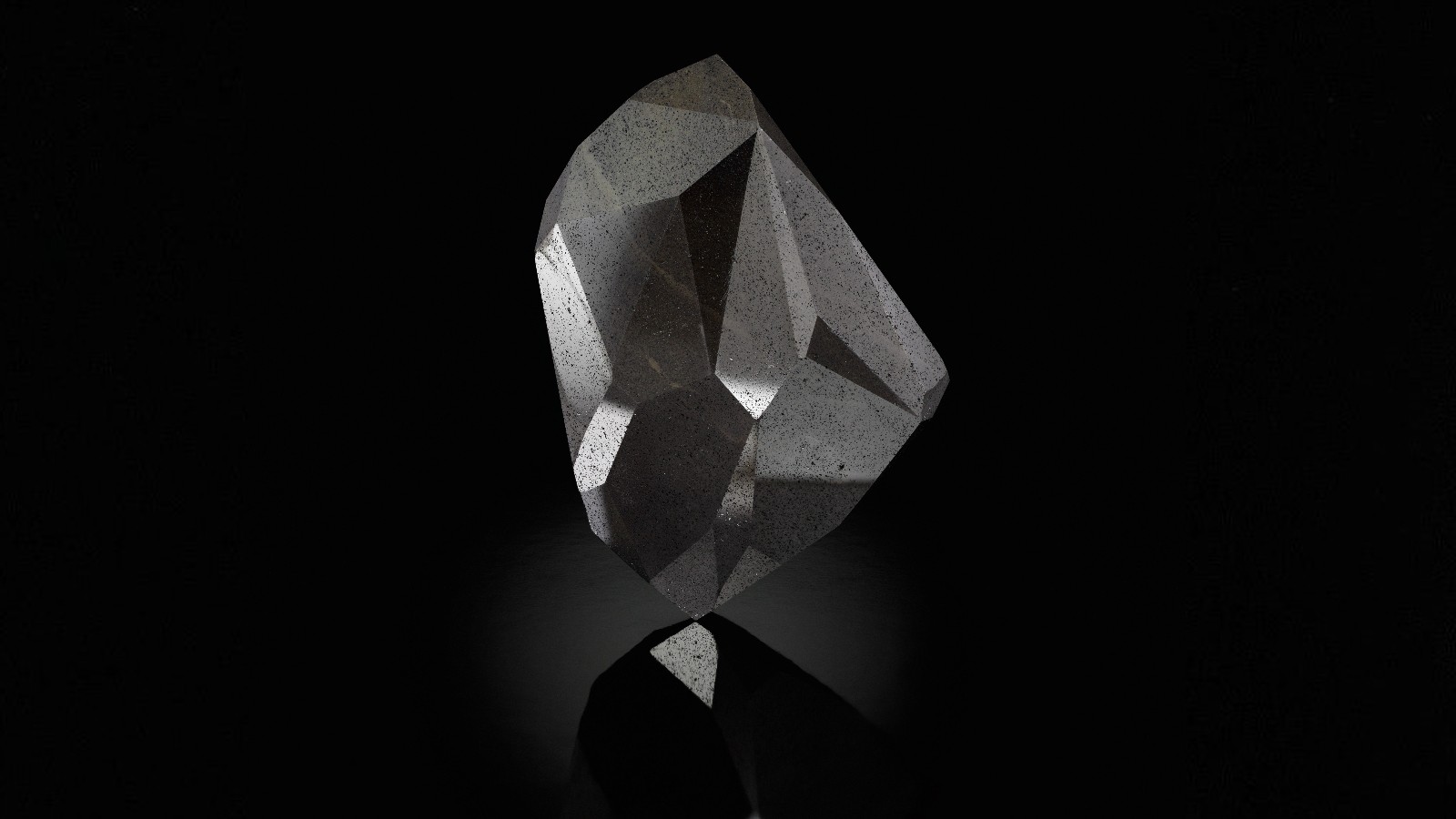55-sided, 555-carat 'Enigma' black diamond (potentially from space) goes on sale
The unique diamond is valued at around $7 million.

One lucky millionaire, or billionaire, will soon be able to get their hands on a one-of-a-kind black diamond, known as the "Enigma," when the shadowy gem goes up for auction next month. But they might not be getting exactly what they paid for.
The Enigma has been artificially cut to weigh exactly 555.55 carats (111 grams) and has 55 black facets. It is currently the largest cut black diamond in the world, according to Guinness World Records.
"The shape of the diamond is based on the [five-fingered] Middle-Eastern palm symbol of the Khamsa, which stands for strength and protection," jewelry specialist Sophie Stevens told the Associated Press. (Khamsa means "five" in Arabic.)
Auction house Sotheby's unveiled the unique gemstone in Dubai, United Arab Emirates, on Jan. 17. The diamond will also be displayed in Los Angeles before arriving in London to be auctioned on Feb. 3. Sotheby's estimates the Enigma will eventually sell for at least $6.8 million. Cryptocurrency bids will also be accepted by the auction house.
Related: Sinister sparkle gallery: 13 mysterious and cursed gemstones
In addition to the diamond's unusual color and unique weight and shape, one of the main selling points is that it may have originated from space. According to a statement from Sotheby's, the Enigma is "thought to have been created either from a meteoric impact or having actually emerged from a diamond-bearing asteroid that collided with Earth." However, black-diamond experts have told Live Science that they are skeptical of the company's claim and said the gemstone probably originated on Earth.

Black diamonds
Black diamonds have high densities of opaque mineral inclusions, particularly graphite — a dark gray form of carbon with a hexagonal structure, unlike diamond, which is a form of carbon in a tetrahedral shape — and metal sulfides, said Peter Heaney, a geoscience professor at Penn State and a black-diamond expert.
Sign up for the Live Science daily newsletter now
Get the world’s most fascinating discoveries delivered straight to your inbox.
Sotheby's describes the Enigma as a carbonado diamond, a Portuguese name given to black diamonds in the 19th century. However, "not all black diamonds are carbonados," Heaney told Live Science. Rather, a carbonado is a type of black diamond that is both polycrystalline, meaning multiple crystals fused into a single gem, and porous, Heaney said. Carbonado diamonds also contain uranium-rich phosphates, which generate "radiation halos" around the pores, or holes, on their surfaces. This trait makes them highly absorptive of white light, making them completely opaque and much darker than other black diamonds, Heaney said.
"Carbonados are superhard and supertough," due to their polycrystalline and porous properties, Heaney said. This makes them perfect for industrial use, such as drill bits used in the oil industry for penetrating hard igneous rocks, he added.
Considering its large size, the Enigma is most likely a true carbonado, Heaney said. After looking at magnified images on his computer, he believes the Enigma is pitted (meaning it is porous), which is suggestive of a carbonado, but it is hard to tell for sure because the diamond has been cut. It is also hard to tell from the images if the diamond is truly opaque, he added.
Uncertain origins
All known carbonados have been found in either Brazil or the Central African Republic and date back to roughly 3.8 billion years ago, Heaney said. During this time, the two countries were part of the same supercontinent known as Rodinia, exactly how and where the diamonds formed is still unclear.

It is possible that carbonados do have an extraterrestrial origin, as the auction house claims. Scientists have found black diamonds created from the impacts of meteorites in the past, but these diamonds are normally very small, which makes it an unlikely origin for true carbonados as large as the Enigma, Heaney said. "I would be quite surprised if a diamond that large originated from a meteorite impact," he said.
Other space-based theories speculate that fully formed carbonados could already exist in some asteroids that crash to Earth or even that the diamonds are formed by powerful stellar explosions called supernovas, but there is not enough evidence to support either of those ideas, Heaney said.
"I believe the chances of carbonado specimens we’ve studied and seen data for being from outer space are low," Richard Ketcham, a geoscientist at the University of Texas at Austin, who has also studied black diamonds, told Live Science. The idea of carbonados originating from space is the "minority viewpoint among those who study them," he added.
Instead, Heaney and Ketcham believe the most likely origin of carbonados is here on Earth. However, the exact mechanism that forms these black diamonds isn't yet clear. Most diamonds form when high pressures in Earth's middle layer, or mantle, crush organic carbon. But the oldest carbonados potentially predate life on Earth — and, therefore, organic carbon — which makes it unlikely that they formed this way.
After searching for a definitive origin of carbonados for close to a decade, Heaney has come up "empty-handed" and, as a result, believes that more research is needed. "I am not persuaded that anyone has fully answered the question," he said.
Because the Enigma has been cut, it is also much harder to be able to tell how it may have originated, Ketcham said. "The outer surfaces of carbonados likely have clues bearing on their origin, which are now probably lost," in the Enigma, he added. The auction house's claim that the Enigma came from space, therefore, seems dubious.
Regardless of how the diamond came into existence, Heaney hopes that whoever ends up buying the Enigma will put it on public display rather than hiding it away in a private collection. "Many great diamonds have not seen the light of day for decades," Heaney said. "Museums cannot compete with billionaires for the purchase of natural wonders."
Originally published on Live Science.

Harry is a U.K.-based senior staff writer at Live Science. He studied marine biology at the University of Exeter before training to become a journalist. He covers a wide range of topics including space exploration, planetary science, space weather, climate change, animal behavior and paleontology. His recent work on the solar maximum won "best space submission" at the 2024 Aerospace Media Awards and was shortlisted in the "top scoop" category at the NCTJ Awards for Excellence in 2023. He also writes Live Science's weekly Earth from space series.










